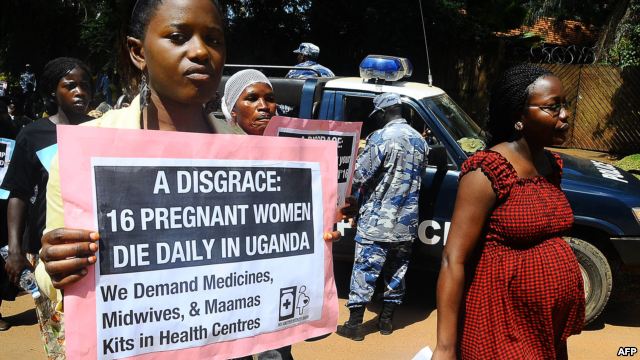By Andrew Green
KAMPALA – Uganda’s health activists are demanding an increase in skilled medical workers to save the lives of the country’s mothers. An advocacy coalition has kept national attention focused on the issue for more than a year. But, as 16 women continue to die every day from complications giving birth, activists have yet to realize any new funding for health workers.
Tragic case recalled
Jennifer Anguko bled to death in a government hospital in October 2010, waiting to deliver her child. As her husband, Valente Inziku, begged health workers for attention, he says his wife told him she was dying and then lost consciousness. By the time Inziku convinced someone to help, it was too late. Their unborn child died as well. More than a year later, Inziku says he is still struggling to raise their older three children alone.
“How am I going to bring up the children? That’s now the question I’m asking myself,” Inziku wondered.
Calls for change
Anguko’s death became one of the rallying points for a coalition of Ugandan health activists to reduce maternal mortality. Uganda has seen maternal death rates almost cut in half in the past 20 years, but it remains one of the most dangerous countries in the world to give birth. The United Nations Population Fund says Uganda registers 310 maternal deaths per 100,000 live births.
Activists argue the majority of maternal deaths could be prevented with more health workers and consistent access to medical supplies.
Uganda has 2,500 government health centers, but nearly 50 percent of the positions are unfilled. That means at least one out of every two pregnant women has no skilled medical person to help them give birth. The U.N. Population Fund says at least 2,000 more midwives are needed to address the situation.
Without more midwives and nurses in the system, Rukia Nansubuga, a grassroots organizer in Kampala, says expectant mothers will continue to suffer and die, so they will not even go to medical centers.
“They fear to go to health centers, because the health centers are not well-facilitated. The health workers are not well-facilitated,”Nansubuga said. “The ones who go there are neglected.”
Civil society groups joined forces a year ago to more effectively pressure the government. Robina Biteyi is the national coordinator of the White Ribbon Alliance. “This is a very good development, because we have all worked on maternal and newborn health, but separately,” she noted. “We felt we needed to come together and make sure we have more strength in demanding for accountability for maternal, newborn and child health.”
The coalition took the unusual step last year of suing the government in constitutional court, arguing that women’s right to life was undermined by health worker shortages and a lack of supplies. They also initiated an international resolution calling for governments to prioritize safe motherhood, which was passed in April at a meeting in Kampala.
Setbacks
Although the efforts have raised the profile of the maternal mortality crisis, they have not yet resulted in a concrete victory. In early June, the constitutional court threw out the case against the government, saying it was a political issue.
Sylveria Alwoch, of the Uganda National Health Consumers Organization, says the decision was a setback, but it will not undermine the coalition’s larger efforts.
“We are still there and we are going to continue advocating. Advocacy doesn’t end in one day,” said Alwoch. “And, when you get disappointed, it doesn’t mean you go and cover your head and stop there.”
Despite the court setback and the Ministry of Health’s announcement that there would be no new funding for health workers this year, the groups are continuing to lobby the government ahead of the release of the budget this month, hoping money will be reallocated for hiring.

